Papaver somniferum
Papaver somniferum, commonly known as the opium poppy[2] or breadseed poppy,[3] is a species of flowering plant in the family Papaveraceae. It is the species of plant from which opium and poppy seeds are derived and is a valuable ornamental plant, grown in gardens. Its native range is probably the eastern Mediterranean, but is now obscured by ancient introductions and cultivation, being naturalized across much of Europe and Asia.
| Papaver somniferum | |
|---|---|
 | |
| Scientific classification | |
| Kingdom: | Plantae |
| Clade: | Tracheophytes |
| Clade: | Angiosperms |
| Clade: | Eudicots |
| Order: | Ranunculales |
| Family: | Papaveraceae |
| Genus: | Papaver |
| Species: | P. somniferum |
| Binomial name | |
| Papaver somniferum L.[1] | |
This poppy is grown as an agricultural crop on a large scale, for one of three primary purposes. The first is to produce seeds that are eaten by humans, known commonly as poppy seed. The second is to produce opium for use mainly by the pharmaceutical industry.[4] The third is to produce other alkaloids, mainly thebaine and oripavine, that are processed by the pharmaceutical industry into drugs such as hydrocodone and oxycodone.[4] Each of these goals has special breeds that are targeted at one of these businesses, and breeding efforts (including biotechnological ones) are continually underway.[4][5][6] A comparatively small amount of Papaver somniferum is also produced commercially for ornamental purposes.
It is increasingly a misnomer to call Papaver somniferum the opium poppy—as many varieties have been bred, and continue to be bred, that do not produce a significant quantity of opium.[3][5] The variety known as Sujata produces no latex at all.[6] Breadseed poppy is more accurate as a common name today because all varieties of Papaver somniferum produce edible seeds. This differentiation has strong implications for legal policy surrounding the growing of this plant.[5]
Description
.jpg)
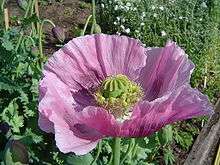
Papaver somniferum is an annual herb growing to about 100 cm (40 in) tall. The plant is strongly glaucous, giving a greyish-green appearance, and the stem and leaves bear a sparse distribution of coarse hairs. The large leaves are lobed, the upper stem leaves clasping the stem,[7] the lowest leaves with a short petiole.[8]:40 It blooms between June and August.[9] The flowers are up to 30–100 mm (1–4 in) diameter, normally with four white, mauve or red petals, sometimes with dark markings at the base. The fruit is a hairless, rounded capsule topped with 12–18 radiating stigmatic rays, or fluted cap.[9] All parts of the plant exude white latex when wounded.[7]:87[10]:32
Papaver somniferum was formally described by the Swedish botanist Carl Linnaeus in his seminal publication Species Plantarum in 1753 on page 508.[11][12]
Varieties and cultivars
Papaver somniferum has had a very long tradition of use, starting in the Neolithic. This long period of time allowed the development of a broad range of different forms. In total there are 52 botanical varieties.[13] Breeding of Papaver somniferum faces a challenge caused by the contradictory breeding goals for this species.[13] On one hand a very high content of alkaloids is requested for medical uses. The global demand for the alkaloids and the pharmaceutical derivatives has increased in the past years. Therefore, there is a need for the development of high opium yielding varieties.[14] On the other hand, the food industry demands as low alkaloid contents as possible.[13]
Papaver somniferum has one accepted subspecies, Papaver somniferum subsp. setigerum (DC.) Arcang.[11] It also has many varieties and cultivars. Colors of the flowers vary widely, as do other physical characteristics, such as number and shape of petals, number of flowers and fruits, number of seeds, color of seeds, and production of opium. Papaver somniferum var. paeoniflorum is a variety with flowers that are highly double, and are grown in many colors. P. somniferum var. laciniatum is a variety with flowers that are highly double and deeply lobed. The variety Sujata produces no latex and no utility for opioid production.
Distribution
The native range of opium poppy is probably the Eastern Mediterranean, but extensive cultivation and introduction of the species throughout Europe since ancient times have obscured its origin. It has escaped from cultivation, or has been introduced and become naturalized extensively in all regions of the British Isles, particularly in the south and east[15] and in almost all other countries of the world with suitable, temperate climates.[16]
History
Use of the opium poppy antedates written history. Images of opium poppies have been found in ancient Sumerian artifacts (circa 4000 BC). The making and use of opium was known to the ancient Minoans.[17] Its sap was later named opion by the ancient Greeks, from where it gained its modern name of opium.
Opium was used for treating asthma, stomach illnesses, and bad eyesight.
The First and Second Opium Wars between China, and the British Empire and France took place in the late 1830s to the early 1860s, when the Chinese attempted to stop western traders from selling and later smuggling opium into their country from the large crops grown in India. The British in particular had a deep trade deficit with China, and the sale of British-owned Indian opium helped balance it.
Many modern writers, particularly in the 19th century, have written on the opium poppy and its effects, notably Thomas de Quincey in Confessions of an English Opium Eater.
The French Romantic composer Hector Berlioz used opium for inspiration, subsequently producing his Symphonie Fantastique. In this work, a young artist overdoses on opium and experiences a series of visions of his unrequited love.
The DEA raided Thomas Jefferson's Monticello estate in 1987. It removed the poppy plants that had been planted continually there since Jefferson was alive and using opium from them. Employees of the foundation also destroyed gift shop items like shirts depicting the poppy and packets of the heirloom seed.[18]
Opium poppies (flower and fruit) appear on the coat of arms of the Royal College of Anaesthetists.
Metabolism
The alkaloids are organic nitrogenous compounds, derivatives of secondary metabolism, synthesized through the metabolic pathway of benzylisoquinoline.[19] First, the amino acid phenylalanine, through the enzyme phenylalanine hydroxylase, is transformed into tyrosine. Tyrosine can follow two different routes: by tyrosine hydroxylase it can form L-dopamine (L-DOPA), or it can be reduced to form 4-phenylhydroxyacetaldehyde (4-HPAA). Subsequently, L-DOPA reacts with 4-HPAA and, through a series of reactions, forms (S) -norcoclaurine, which carries the benzylisoquinoline skeleton that gives its name to this pathway. The conversion of (S) -norcoclaurin to (S) -reticulin is one of the key points, since from (S) -reticulin morphine can be formed through the morphinan route, noscapine through the path of the noscapina or berberina.[19]
Genome analysis
The poppy genome contains 51,213 genes encoding proteins distributed 81.6% in 11 individual chromosomes and 18.4% remaining in unplaced scaffolds.[19] In addition, 70.9% of the genome is made up of repetitive elements, of which the most represented are the long terminal repeat retrotransposons. This enrichment of genes is related to the maintenance of homeostasis and a positive regulation of transcription.[19]
The analysis of synergy of the opium poppy reveals traces of segmental duplications 110 million years ago (MYA), before the divergence between Papaveraceae and Ranunculaceae, and an event of duplication of the complete genome makes 7.8 MYA.
The genes are possibly grouped as follows:[19]
- The genes responsible for the conversion of (S) -reticulin to noscapine are found on chromosome 11.
- The genes responsible for the conversion of (S) -reticulin to thebaine are found on chromosome 11.
- The genes responsible for the conversion of thebaine are found in chromosome 1, chromosome 2, chromosome 7, and perhaps others.
Uses
Poppy seeds and oil
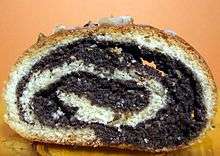
Poppy seeds from Papaver somniferum are an important food item and the source of poppyseed oil, an edible oil that has many uses. The seeds contain very low levels of opiates and the oil extracted from them contains even less.[20] Both the oil and the seed residue also have commercial uses.
The poppy press cake as a residue of the oil pressing can be used as fodder for different animals as e.g. poultry and fancy fowls. Especially in the time of the molt of the birds, the cake is nutritive and fits to their special needs. Next to the animal fodder, poppy offers other by-products. For example, the stem of the plant can be used for energy brickets and pellets to heat.[21]
Poppy seeds are used as a food in many cultures. They may be used whole by bakers to decorate their products or milled and mixed with sugar as a sweet filling. They have a creamy and nut-like flavor, and when used with ground coconut, the seeds provide a unique and flavour-rich curry base. They can be dry roasted and ground to be used in wet curry (curry paste) or dry curry.[22]
When the European Union attempted to ban the cultivation of Papaver somniferum by private individuals on a small scale (such as personal gardens), citizens in EU countries where poppy seed is eaten heavily, such as countries in the Central-Eastern region, strongly resisted the plan, causing the EU to change course. Singapore, UAE, and Saudi Arabia are among nations that ban even having poppy seeds, not just growing the plants for them.[23] The UAE has a long prison sentence for anyone possessing poppy seeds.[24]
Opiates
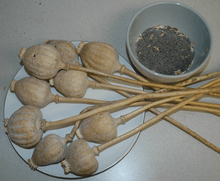
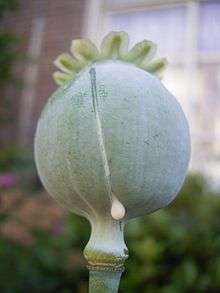
The opium poppy, as its name indicates, is the principal source of opium, the dried latex produced by the seed pods. Opium contains a class of naturally occurring alkaloids known as opiates, that include morphine, thebaine, codeine, papaverine, noscapine and oripavine. The specific epithet somniferum means "sleep-bringing", referring to the sedative properties of some of these opiates.[25]
The opiate drugs are extracted from opium. The latex oozes from incisions made on the green seed pods and is collected once dry. Tincture of opium or laudanum, consisting of opium dissolved in alcohol or a mixture of alcohol and water, is one of many unapproved drugs regulated by the U.S. Food and Drug Administration (FDA). Its marketing and distribution persists because its historical use preceded the Federal Food, Drug & Cosmetic Act of 1938.[26] Tincture of opium B.P., containing 1% w/v of anhydrous morphine, also remains in the British Pharmacopoeia,[27] listed as a Class A substance under the Misuse of Drugs Act 1971.
Morphine is the predominant alkaloid found in the cultivated varieties of opium poppy that are used for opium production.[28] Other varieties produce minimal opium or none at all, such as the latex-free Sujata type. Non-opium cultivars that are planted for drug production feature a high level of thebaine or orpivine. Those are refined into drugs like oxycodone. Raw opium contains about 8–14% morphine by dry weight, or more in high-yield cultivars.[29] It may be used directly or chemically modified to produce synthetic opioids such as heroin.
Ornamental cultivation
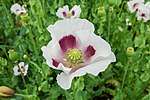
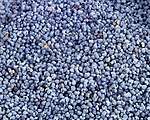
Live plants and seeds of the opium poppy are widely sold by seed companies and nurseries in most of the western world, including the United States. Poppies are sought after by gardeners for the vivid coloration of the blooms, the hardiness and reliability of the poppy plants, the exotic chocolate-vegetal fragrance note of some cultivars, and the ease of growing the plants from purchased flats of seedlings or by direct sowing of the seed. Poppy seed pods are also sold for dried flower arrangements.
Since "opium poppy and poppy straw" are listed in Schedule II of the United States' Controlled Substances Act, a DEA license may be required to grow poppies in ornamental or display gardens. In fact, the legal status of strictly ornamental poppy gardens is more nuanced. During the summer, opium poppies can be seen flowering in gardens throughout North America and Europe, and displays are found in many private plantings, as well as in public botanical and museum gardens such as United States Botanical Garden, Missouri Botanical Garden, and North Carolina Botanical Garden.
Many countries grow the plants, and some rely heavily on the commercial production of the drug as a major source of income. As an additional source of profit, the seeds of the same plants are sold for use in foods, so the cultivation of the plant is a significant source of income. This international trade in seeds of P. somniferum was addressed by a UN resolution "to fight the international trade in illicit opium poppy seeds" on 28 July 1998.
As many non-opium cultivars are available, there has been a shift to selling ornamental varieties of those types. Unlike opium-heavy varieties, these cannot be easily processed into usable narcotics by anyone lacking the requisite lab. The Sujata type produces no latex at all so it cannot be used for any kind of drug production.
Market
Food
| Poppy seed production – 2016 | |
|---|---|
| Country | (tonnes) |
| 28,574 | |
| 18,205 | |
| 13,377 | |
| 8,948 | |
| 5,777 | |
| 92,610 | |
| Source: FAOSTAT of the United Nations[30] | |
In 2016, world production of poppy seeds for consumption was 92,610 tonnes, led by the Czech Republic with 31% of the world total (table). Turkey and Spain were other major producers.[30] World production of poppy seed is increasing, with the highest growth rate in Eastern Europe. However, poppy seed production and trade is susceptible to fluctuations mainly due to unstable yields. The performance of most genotypes of "Papaver somniferum" is very susceptible to environmental changes [31] This behaviour led to a stagnation of the poppy seed market value between 2008–2009 as a consequence of high stock levels, bad weather and poor quality.[32] The world leading importer of poppy seed is India (16 000 tonnes), followed by Russia, Poland and Germany.[33]
In Europe, poppy seed products appear promising in the organic and speciality market. However, poppy seed oil remains a niche product due to the lower yield compared to conventional oil crops.[34]
The New York Times reported, in 2014, that Tasmania was the largest producer of the poppy cultivars used for thebaine (85% of the world's supply) and oripavine (100% of the world's supply) production. Tasmania also had 25% of the world's opium and codeine production.[4]
Medicine
Australia (Tasmania), Turkey and India are the major producers of poppy for medicinal purposes and poppy-based drugs, such as morphine or codeine.[35][14] The USA has a policy of sourcing 80% of its narcotic raw materials from the traditional producers, India and Turkey.[36]
A recent initiative to extend opium production for medicinal purposes called Poppy for Medicine was launched by The Senlis Council which proposes that Afghanistan could produce medicinal opium under a scheme similar to that operating in Turkey and India.[37]
In late 2007, the British government permitted the pharmaceutical company Macfarlan Smith (a Johnson Matthey company, FTSE 100) to cultivate opium poppies in England for medicinal reasons[38] after Macfarlan Smith's primary source, India, decided to increase the price of export opium latex. The Office of Fair Trading has alerted the government to their monopoly position on growing in the UK and worldwide production of diamorphine and recommended consideration.[38] The government's response advocated the status quo, being concerned interference might cause the company to stop production.[39]
Cultivation
In the growth development of Papaver somniferum six stages can be distinguished. The growth development starts with the growth of the seedlings. In a second step the rosette-type leaves and stalks are formed. After that budding (hook stage) takes place as a third step. The hook stage is followed by flowering. Subsequently, technical maturity is reached, which means that the plant is ready for cutting. The last step is biological maturity; dry seeds are ripened. The photoperiod seems to be the main determinant of flower development of Papaver somniferum.[40]
Papaver somniferum shows a very slow development in the beginning of its vegetation period. Due to this fact the competition of weeds is very high in early stages. It is very important to control weeds effectively in the first 50 days after sowing.[41] Additionally Papaver somniferum is rather susceptible to herbicides. The pre-emergence application of the herbicide chlortoluron has been shown to be effective in reducing weed levels.[41] However, in the last decade the weed management of Papaver somniferum has shifted from pre-emergence treatments to post-emergence treatments.[42] Especially the application of the two herbicides mesotrione and tembotrione has become very popular. The combined application of those two herbicides has been shown to be recommendable for effective weed management in Papaver somniferum.[42] Sowing time (autumn or spring), preceding crop and soil texture are important variables influencing the weed species composition. A highly abundant weed species in Papaver somniferum fields was shown to be Papaver rhoeas.[42][43] Papaver somniferum and Papaver rhoeas belong to the same plant family, which impedes the chemical control of this weed species.[43] Therefore, weed management represents a big challenge and requires technological knowledge from the farmer.[43] In order to increase the efficiency of weed control not only chemical weed control should be applied but also mechanical weed control.[43]
Diseases
Papaver somniferum is susceptible to several fungal, insect and virus infections including seed borne diseases such as downy mildew and root rot. The use of pesticides in combination to cultural methods have been considered as major control measures for various poppy diseases.[44]
The fungal pathogen Peronospora arborescensis, the causal agent of downy mildew, occurs preferentially during wet and humid conditions.[21] This oomycete penetrates the roots through oospores and infects the leaves as conidia in a secondary infection.[45] The fungus causes hypertrophy and curvature of the stem and flower stalks.[46] The symptoms are chlorosis and curling of the affected tissues with necrotic spots.[47] The leaf under-surface is covered with a downy mildew coating containing conidiospores that spread the infection further leading to plant damage and death.[48] Another downy mildew species, Peronospora somniferi, produces systemic infections leading to stunting and deformation of poppy plants.[49] Downy mildew can be controlled preventively at the initial stage of seed development through several fungicide applications.[21]
Leaf blight caused by the fungus Helminthosporium papaveris is one of the most destructive poppy diseases worldwide. The seed-borne fungus causes root rot in young plants and stunted stems in plants at a higher development stage, where leaf spots appear on the leaves and is being transmitted to capsules and seeds.[48] Early sowing of seeds and deep plowing of poppy residues can reduce fungal inoculum during the plant growing season in the following year on neighboring poppy stocks, respectively.[21]
Mosaic diseases in p. somniferum are caused by rattle virus and the Carlavirus.[44] In 2006, a novel virus tentatively called "opium poppy mosaic virus" (OPMV) from the genus Umbravirus was isolated from p. somniferum containing leaf mosaic and mottling symptoms, in New Zealand.[50]
Pests
There are only few pests that can really harm P. somniferum.[21]
Flea beetles perforate the leaves of young plants and aphids suck on the sap of the flower buds.[21] The poppy root weevil is another significant pest. The insect lives in the soil and migrates in spring to the poppy fields after crop emergence. Adults damage the leaves of small plants by eating them. Female lay their eggs into the tissue of lower leaves. Insect larvae hatch and burrow into the soil to complete their life cycle on the poppy roots as adults.[51]
Restrictions
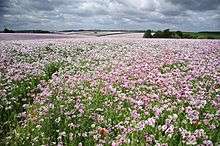

In most of Central Europe, poppyseed is commonly used for traditional pastries and cakes, and it is legal to grow poppies throughout the region, although Germany requires a license.[52]
Since January 1999 in the Czech Republic, according to the 167/1998 Sb. Addictive Substances Act, poppies growing in fields larger than 100 square metres (120 sq yd) is obliged for reporting to the local Custom Office.[53][54] Extraction of opium from the plants is prohibited by law (§ 15 letter d/ of the act). It is also prohibited to grow varieties with more than 0.8% of morphine in dry matter of their capsules, excluding research and experimental purposes (§24/1b/ of the act). The name Czech blue poppy refers to blue poppy seeds used for food.
The United Kingdom does not require a license for opium poppy cultivation, but does for extracting opium for medicinal products.[55]
In the United States, opium poppies and poppy straw are prohibited.[56] As the opium poppy is legal for culinary or esthetic reasons, poppies were once grown as a cash crop by farmers in California. The law of poppy cultivation in the United States is somewhat ambiguous.[57] The reason for the ambiguity is because the Opium Poppy Control Act of 1942 (now repealed)[58][59] stated that any opium poppies should be declared illegal, even if the farmers were issued a state permit. § 3 of the Opium Poppy Control Act stated:
It shall be unlawful for any person who is not the holder of a license authorizing him to produce the opium poppy, duly issued to him by the Secretary of the Treasury in accordance with the provisions of this Act, to produce the opium poppy, or to permit the production of the opium poppy in or upon any place owned, occupied, used, or controlled by him.
This led to the Poppy Rebellion, and to the Narcotics Bureau arresting anyone planting opium poppies and forcing the destruction of poppy fields of anyone who defied the prohibition of poppy cultivation.[60][61] Though the press of those days favored the Federal Bureau of Narcotics, the state of California supported the farmers who grew opium poppies for their seeds for uses in foods such as poppyseed muffins. Today, this area of law has remained vague and remains somewhat controversial in the United States.[62] The Opium Poppy Control Act of 1942 was repealed on 27 October 1970.[63][64] Canada forbids possessing, seeking or obtaining the opium poppy (Papaver somniferum), its preparations, derivatives, alkaloids and salts, although an exception is made for poppyseed.[65]
In some parts of Australia, P. somniferum is illegal to cultivate, but in Tasmania, some 50% of the world supply is cultivated.[66] In New Zealand, it is legal to cultivate the opium poppy as long as it is not used to produce banned drugs.[67]
In United Arab Emirates the cultivation of the opium poppy is illegal, as is possession of poppyseed. At least one man has been imprisoned for possessing poppyseed obtained from a bread roll.[68]
Burma bans cultivation in certain provinces. In northern Burma bans have ended a century-old tradition of growing the opium poppy. Between 20,000 and 30,000 former poppy farmers left the Kokang region as a result of the ban in 2002.[69] People from the Wa region, where the ban was implemented in 2005, fled to areas where growing opium is still possible.
References
- Linnaeus, Carl von (1753). Species Plantarum. vol. 1. Laurentius Salvius. p. 508.
- "BSBI List 2007". Botanical Society of Britain and Ireland. Archived from the original (xls) on 23 October 2014. Retrieved 17 October 2014.
- "Breadseed or opium poppy, Papaver somniferum". University of Wisconsin Extension, Master Gardener Program. Retrieved 7 January 2018.
- "Shake-Up on Opium Island". The New York Times. Retrieved 8 January 2018.
- Gaevskii, A.V. (1999). "On the intraspecies classification of opium poppy (Papaver somniferum L.)". Khimiko-Farmatsevticheskii Zhurnal. 33 (3): 32–36. doi:10.1007/BF02508453.
- Chaturvedi, Nidarshana (2014). "Latex-less opium poppy: cause for less latex and reduced peduncle strength)" (PDF). Physiologia Plantarum. 150 (3): 436–445. doi:10.1111/ppl.12086. PMID 24033330. Retrieved 7 January 2018.
- Stace, C. A. (2010). New Flora of the British Isles (Third ed.). Cambridge, U.K.: Cambridge University Press. ISBN 9780521707725.
- Clapham, A.R.; Tutin, T.G.; Warburg, E.F. (1981). Excursion flora of the British Isles (3 ed.). Cambridge, U.K.: Cambridge University Press. ISBN 978-0521232906.
- Reader's Digest Field Guide to the Wild Flowers of Britain. Reader's Digest. 1981. p. 32. ISBN 9780276002175.
- Blamey, M.; Fitter, R.; Fitter, A (2003). Wild flowers of Britain and Ireland: The Complete Guide to the British and Irish Flora. London: A & C Black. ISBN 978-1408179505.
- "Papaver somniferum L. is an accepted name". theplantlist.org. 23 March 2012. Retrieved 1 November 2017.
- Papaveraceae Papaver somniferum L. 1. ipni.org. Retrieved 1 November 2017.
- Dittbrenner, A. (2009). "Variability of alkaloid content in Papaver somniferum L". Journal of Applied Botany and Food Quality. 107: 103–107.
- Yadav, Hemant K.; Shukla, S.; Singh, S. P. (16 August 2006). "Genetic Variability and Interrelationship Among Opium and its Alkaloids in Opium Poppy (Papaver Somniferum L.)". Euphytica. 150 (1–2): 207–214. doi:10.1007/s10681-006-9111-x. ISSN 0014-2336.
- "BSBI Distribution Maps, Papaver somniferum". London, U.K.: Botanical Society of Britain and Ireland. 22 April 2016.
- "Papaver somniferum L." Copenhagen, Denmark: Global Biodiversity Information Facility, GBIF.org.
- Askitopoulou, Helen; Ramoutsaki, Ioanna A; Konsolaki, Eleni (2002). "Archaeological evidence on the use of opium in the Minoan world". International Congress Series. 1242: 23–29. doi:10.1016/S0531-5131(02)00769-0.
- "How the DEA Scrubbed Thomas Jefferson's Monticello Poppy Garden from Public Memory". AlterNet. 2 March 2010. Archived from the original on 4 December 2018. Retrieved 7 January 2018.
- Ye, Kai; Graham, Ian A.; Bowser, Tim A.; Lu, Ying; Teodor, Roxana; He, Zhesi; Ning, Zemin; Li, Yi; Yang, Xiaofei (19 October 2018). "The opium poppy genome and morphinan production". Science. 362 (6412): 343–347. doi:10.1126/science.aat4096. ISSN 0036-8075. PMID 30166436.
- "Papaver somniferum". www.hort.purdue.edu.
- Wilfried., Ahrens (2000). Mohn : Sorten, Anbau, Rezepte. Sneyd, Jan. Stuttgart (Hohenheim): Ulmer. ISBN 978-3800131129. OCLC 76179514.
- "Mahanandi » Gasagasalu ~ Bendakaaya". Nandyala.org. Retrieved 30 December 2011.
- "5 Recent Food Bans from Around the World". Times of India. Retrieved 8 January 2018.
- "Travel Warning – Khas Khas (Poppy Seed) Imprisonment in UAE". Brett M.Christensen. Retrieved 8 January 2018.
- Bronwen Jean Bryant and Kathleen Mary Knights Pharmacology for Health Professionals, p. 290, at Google Books
- "Unapproved Drugs, What's the Big Deal?" (PDF). International Journal of Pharmaceutical Compounding, Winter 2006. Retrieved 3 January 2009.
- The Extra Pharmacopeia Martindale. Vol. 1, 24th edition. London: The Pharmaceutical Press, 1958, page 924.
- "International Narcotics Control Bureau, Technical Reports, 2008, Part IV, Statistical information on narcotic drugs" (PDF). Retrieved 30 December 2011.
- Kapoor L (1995). Opium Poppy: Botany, Chemistry, and pharmacology. United States: CRC Press. p. 164. ISBN 978-1-56024-923-8.
- "Poppy seed production in 2016, Crops/Regions/World list/Production Quantity (pick lists)". UN Food and Agriculture Organization, Corporate Statistical Database (FAOSTAT). 2017. Retrieved 18 April 2018.
- Yadav, H.; Shukla, S.; Singh, S. (2007). "Assessment of genotype × environment interactions for yield and morphine content in opium poppy (Papaver somniferumL.)". Acta Agronomica Hungarica. 55 (3): 331–338. doi:10.1556/AAgr.55.2007.3.9.
- Procházka, Petr; Smutka, Lubos (30 June 2012). "Czech Republic as an Important Producer of Poppy Seed". AGRIS On-line Papers in Economics and Informatics. 4 (2): 35–47. Retrieved 15 November 2018.
- Sergeeva, Anna. "Global Poppy Seed Market – The Czech Republic Is the Key Producing Country". Index Box. Index Box. Retrieved 15 November 2018.
- Frick, Claudia; Hebeisen, Thomas (2005). "Mohn als alternative Ölpflanze". AGRARForschung. 12 (1): 4–9.
- Dicker, Jason. "The Poppy Industry in Tasmania". University of Tasmania. Retrieved 2 September 2009.
- Braund, Claire (2001). "Research driving the Tasmanian poppy industry". Australian Society of Agronomy. Archived from the original on 29 July 2009. Retrieved 2 September 2009.
- "Poppy for Medicine". Poppy for Medicine. Retrieved 2 September 2009.
- "Review of undertakings by Macfarlan Smith Limited". Department for Business, Innovation and Skills. March 2006. Archived from the original on 22 November 2008. Retrieved 2 September 2009.
- "Opium derivatives – Government response to OFT review of undertakings by Macfarlan Smith Limited (MSL)" (PDF). Department for Business, Innovation and Skills. March 2006. Archived from the original (PDF) on 4 December 2009. Retrieved 3 October 2012.
- Mahdavi-Damghani, Abdolmajid; Kamkar, Behnam; Al-Ahmadi, Majid Jami; Testi, Luca; Muñoz-Ledesma, Francisco J.; Villalobos, Francisco J. (October 2010). "Water stress effects on growth, development and yield of opium poppy (Papaver somniferum L.)" (PDF). Agricultural Water Management. 97 (10): 1582–1590. doi:10.1016/j.agwat.2010.05.011. hdl:10261/94915. ISSN 0378-3774.
- Gaur, B. L.; Gupta, P. C.; Sharma, D. D. (January 1986). "Weed management in opium poppyPapaver somniferumL". Tropical Pest Management. 32 (4): 267–268. doi:10.1080/09670878609371076. ISSN 0143-6147.
- Pinke, Gyula; Tóth, Kálmán; Kovács, Attila J.; Milics, Gábor; Varga, Zoltán; Blazsek, Katinka; Gál, Katalin E.; Botta-Dukát, Zoltán (3 July 2014). "Use of mesotrione and tembotrione herbicides for post-emergence weed control in alkaloid poppy (Papaver somniferum)". International Journal of Pest Management. 60 (3): 187–195. doi:10.1080/09670874.2014.953622. ISSN 0967-0874.
- PINKE, G; PÁL, R W; TÓTH, K; KARÁCSONY, P; CZÚCZ, B; BOTTA-DUKÁT, Z (16 September 2011). "Weed vegetation of poppy (Papaver somniferum) fields in Hungary: effects of management and environmental factors on species composition". Weed Research. 51 (6): 621–630. doi:10.1111/j.1365-3180.2011.00885.x. ISSN 0043-1737.
- Singh, Akanksha; Gupta, Rupali; Saikia, Shilpi K.; Pant, Aakanksha; Pandey, Rakesh (December 2016). "Diseases of medicinal and aromatic plants, their biological impact and management". Plant Genetic Resources. 14 (4): 370–383. doi:10.1017/S1479262116000307. ISSN 1479-2621.
- Voglmayr, Hermann; Montes-Borrego, Miguel; Landa, Blanca B. (7 May 2014). "Disentangling Peronospora on Papaver: Phylogenetics, Taxonomy, Nomenclature and Host Range of Downy Mildew of Opium Poppy (Papaver somniferum) and Related Species". PLoS ONE. 9 (5): e96838. doi:10.1371/journal.pone.0096838. ISSN 1932-6203. PMC 4013089. PMID 24806292.
- Bajpai, S.; Gupta, M. M.; Kumar, S. (September 1999). "Identification of Indian Landraces of Opium Poppy Papaver somniferum Resistant to Damping-off and Downy Mildew Fungal Diseases". Journal of Phytopathology. 147 (9): 535–538. doi:10.1046/j.1439-0434.1999.147009535.x. ISSN 0931-1785.
- Barnawal, D.; Pandey, S.S.; Bharti, N.; Pandey, A.; Ray, T.; Singh, S.; Chanotiya, C.S.; Kalra, A. (3 April 2017). "ACC deaminase-containing plant growth-promoting rhizobacteria protect Papaver somniferum from downy mildew". Journal of Applied Microbiology. 122 (5): 1286–1298. doi:10.1111/jam.13417. ISSN 1364-5072. PMID 28186676.
- D., Kapoor, L. (1995). Opium poppy : botany, chemistry, and pharmacology. New York: Food Products Press. ISBN 978-1560249238. OCLC 30544395.
- Thangavel, T.; Wilson, C. R.; Jones, S.; Scott, J. B.; Voglmayr, H. (February 2017). "First Report of Systemic Downy Mildew of Opium Poppy Caused by Peronospora somniferi in Australia". Plant Disease. 101 (2): 392. doi:10.1094/pdis-06-16-0796-pdn. ISSN 0191-2917.
- Tang, Joe; Lebas, Bénédicte; Liefting, Lia; Veerakone, Stella; Wei, Ting; Ward, Lisa (29 October 2015). "Opium poppy mosaic virus, a new umbravirus isolated from Papaver somniferum in New Zealand". Archives of Virology. 161 (1): 197–201. doi:10.1007/s00705-015-2651-4. ISSN 0304-8608. PMID 26514844.
- Bečka, D.; Cihlář, P.; Vlažný, P.; Pazderů, K.; Vašák, J. (3 October 2014). "Poppy root weevils (Stenocarus ruficornis, Stephens 1831) control in opium poppy (Papaver somniferum L.)". Plant, Soil and Environment. 60 (10): 470–474. doi:10.17221/417/2014-pse. ISSN 1214-1178.
- Ursula Heinzelmann (2008) Food Culture in Germany p. 48
- 167/1998 Sb. Zákon o návykových látkách a o změně některých dalších zákonů, Czech Republic, effective since 1 January 1999; § 29 effective since 1 January 1999; § 29
- Ohlašovací povinnost pěstitelů máku a konopí podle par. 29 zákona č. 167/1999 Sb., o návykových látkách, Celní správa (Custom Service of the Czech Republic), 19. 6. 2014
- Phillip, Rhodri, & Barry Wigmore (14 July 2007). "The painkilling fields: England's opium poppies that tackle the NHS morphine crisis". Evening Standard. Retrieved 2 September 2009.CS1 maint: multiple names: authors list (link)
- "Authorized Sources of Narcotic Raw Materials, 21 CFR Part 1312; Docket No. DEA-282F, RIN 1117-AB03". Drug Enforcement Administration, US Department of Justice. 2008. Retrieved 13 September 2017.
- "Bulletin on Narcotics – 1950 Issue 3 – 002". UNODC. Retrieved 30 December 2011.
- "Controlled Substances Import and Export Act". US Food and Drug Administration. Retrieved 30 December 2011.
- "21 U.S.C. § 188 : US Code – Section 188 TO 188N: Repealed. Pub. L. 91-513, title III, Sec. 1101(a)(7), Oct. 27, 1970, 84 Stat. 1292". Codes.lp.findlaw.com. Retrieved 30 December 2011.
- Harry J. Anslinger (1959). "The traffic in narcotic drugs: The implementation of treaty obligations in regulating the traffic in narcotic drugs" (PDF). The American University Law Review. 8: 112–116.
- Young, David (September 1952). "The international control of narcotic drugs". American Bar Association Journal. 38: 778–80.
- "Poppin' Up Poppies". Texasgardener.com. Retrieved 30 December 2011.
- "United States Code: Title 21,188 to 188n. Repealed. Pub. L. 91–513, title III, 1101(a)(7), Oct. 27, 1970, 84 Stat. 1292 | LII / Legal Information Institute". Law.cornell.edu. Retrieved 30 December 2011.
- "21 USC Chapter 6 – Narcotic Drugs 01/03/2007". Joffelaw.com. Retrieved 30 December 2011.
- "Controlled Drugs and Substances Act 1996". Justice Laws Website, Government of Canada. 4 April 2018. Retrieved 20 June 2018.
- "Poppy Regulation Act". Department of Primary Industry and Resources, Northern Territory Government, Australia. 2016.
- Section 9(4) of the Misuse of Drugs Act states, "It shall be a defense to a charge under subsection (1) [Cultivation of prohibited plants] if the person charged proves that the prohibited plant to which the charge relates was of the species Papaver somniferum, and that it was not intended to be a source of any controlled drug or that it was not being developed as a strain from which a controlled drug could be produced.""New Zealand Legislation: Misuse of Drugs Act 1975". Retrieved 7 July 2012.
- McGrath, Ginny (8 February 2008). "Travellers who 'smuggle' poppy seeds face Dubai jail". The Times. UK. Archived from the original on 10 October 2011. Retrieved 2 September 2009.
- page 4 of the Drug Policy Briefing nr. 29 by the Transnational Institute
Bibliography
- The Heroin Harvest(dead link)
- Comprehensive profile for Papaver somniferum from MaltaWildPlants.com
- Opium FAQ v1.0 from Opioids.com
- Opium Poppy Cultivation and Heroin Processing in Southeast Asia from the School of Pacific and Asian Studies (dead link)
- "Downward Spiral – Banning Opium in Afghanistan and Burma", Transnational Institute TNI, Debate Paper, June 2005
- "Withdrawal Symptoms in the Golden Triangle – A Drugs Market in Disarray" TNI Paper by Tom Kramer et al.
- Chouvy P.A., 2009, "Opium. Uncovering the Politics of the Poppy", London, I.B. Tauris (Cambridge, Harvard University Press: 2010)
- Rätsch, Christian "The Encyclopedia of Psychoactive Plants, Enthnopharmacology and Its Applications" 1998/2005, Rochester, Vermont, Park Street Press, ISBN 978-0-89281-978-2
| Wikispecies has information related to Papaver somniferum |
| Wikimedia Commons has media related to Papaver somniferum. |